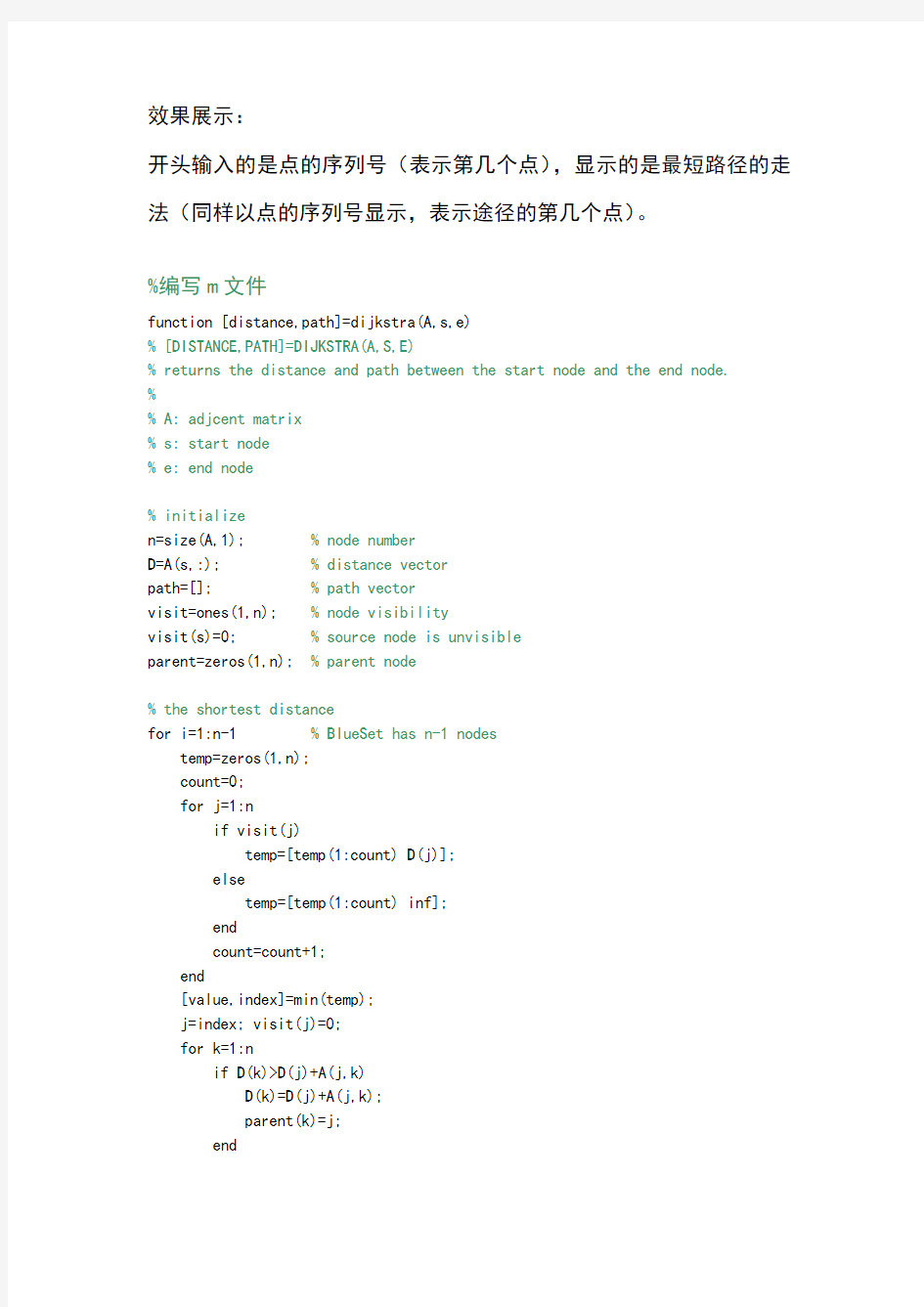暴强Dijkstra算法求任意两点间最短路径


效果展示:
开头输入的是点的序列号(表示第几个点),显示的是最短路径的走法(同样以点的序列号显示,表示途径的第几个点)。
%编写m文件
function [distance,path]=dijkstra(A,s,e)
% [DISTANCE,PATH]=DIJKSTRA(A,S,E)
% returns the distance and path between the start node and the end node.
%
% A: adjcent matrix
% s: start node
% e: end node
% initialize
n=size(A,1); % node number
D=A(s,:); % distance vector
path=[]; % path vector
visit=ones(1,n); % node visibility
visit(s)=0; % source node is unvisible
parent=zeros(1,n); % parent node
% the shortest distance
for i=1:n-1 % BlueSet has n-1 nodes
temp=zeros(1,n);
count=0;
for j=1:n
if visit(j)
temp=[temp(1:count) D(j)];
else
temp=[temp(1:count) inf];
end
count=count+1;
end
[value,index]=min(temp);
j=index; visit(j)=0;
for k=1:n
if D(k)>D(j)+A(j,k)
D(k)=D(j)+A(j,k);
parent(k)=j;
end
end
end
distance=D(e);
% the shortest distance path
if parent(e)==0
return;
end
path=zeros(1,2*n); % path preallocation
t=e; path(1)=t; count=1;
while t~=s && t>0
p=parent(t);
path=[p path(1:count)];
t=p;
count=count+1;
end
if count>=2*n
error(['The path preallocation length is too short.',...
'Please redefine path preallocation parameter.']);
end
path(1)=s;
path=path(1:count);
%算法实现
clc; clear; close all;
%% 载入设置数据
lines = load(''); %点与点之间的距离矩阵
A=lines;
A(find(A>10))=inf; %对步长的限制,根据自己的要求决定!我们在此选择10. % A就是连接矩阵,其中对角线为0,表示本身
% 有连接关系的就对应线的长度
% 没有连接关系的就对应inf
%% 下面的是dijstra算法,有两种方式可以调用
s =input('输入起点'); % 起点(点的序号)
e =input('输入终点'); % 终点(点的序号)
[distance,path0] = dijkstra(A,s,e);
fprintf('\n Use Dijkstra the Min Distance is: %.5f \n', distance); fprintf('\n Use Dijkstra the Min Distance path is: \n');
disp(path0);
A1 = A;
A1(isinf(A1)) = 0;
[d, p, pred] = graphshortestpath(sparse(A1), s, e);
fprintf('\n Use graphshortestpath the Min Distance is: %.5f \n', d); fprintf('\n Use graphshortestpath the Min Distance path is: \n'); disp(p);
for i = 1 : length(path0)
if i == length(path0)
temp = [path0(1) path0(i)];
else
temp = [path0(i) path0(i+1)];
end
end
